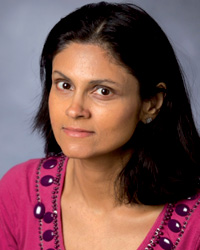One fall day in Boston, Ridhi Tariyal sat on an examination table in her primary care doctor’s office. Her doctor sat across from her, hurriedly transcribing notes as Tariyal responded to the doctor’s questions. It was the end of Tariyal’s physical, and the waiting room was full. “Do you have any questions?” the doctor asked, not turning away from the computer screen.
Tariyal was 33 and in full pursuit of her ambitions. She had just begun a fellowship at Harvard Business School after two and a half years of hunting for the Lassa fever genome in rural Sierra Leone and Nigeria. In the years prior, she had navigated through a series of high-powered positions in finance before obtaining a master’s degree in biomedical enterprise from the Massachusetts Institute of Technology, where she worked with renowned geneticist George Church, eventually developing her own business in India tackling a fatal genetic disorder.
But like thousands of other women in their early thirties, Tariyal knew she was quickly approaching a critical physiological deadline at a very inconvenient time in her highly productive life. The general scientific consensus is that, once a woman reaches 35, pregnancies are more often complicated for mother and child and birth defects are more common. She knew that, if she ever wanted to have kids, she had to start thinking pretty seriously about her options. “Is there a way I can test my fertility just to see if I have any cause to worry?” she asked. “Do you have a specific problem you are worried about?” countered her doctor. She didn’t. “Then no,” the doctor answered, she couldn’t authorize any tests.
The doctor informed her that, if she was serious about getting tested, her best shot was a fertility clinic. Tariyal knew what that meant—out-of-pocket money. And aside from the expense (hundreds, maybe thousands of dollars) for tests, she explains, “When I think about going to a fertility clinic, I feel like they have something to sell me.” And that didn’t sit well. She would rather have the tests done by someone without a vested interest. “At that point,” she remembers, “I saw too many hurdles and knew there should be an easier way for a woman to get that question answered a little more easily and with less resistance.”
Because she had just begun her fellowship at Harvard, Tariyal was in a unique position to explore this question. She connected with George Whitesides, a renowned chemistry professor, to explore the possibilities for simple home fertility tests. The problem, however, was the large amount of blood that all the most informative fertility tests—the ones that interested her the most— required. She then realized the solution was obvious but perhaps only to a woman. What about the menstrual period?

Utilizing her resources at Harvard, Tariyal refined an idea for a diagnostic tampon system that collects and tests menstrual blood. She joined forces with Stephen Gire, a research scientist and close friend from her days chasing viruses in West Africa. Together, they cofounded their company, NextGen Jane, and developed plans for the technology (Figure 1). Originally, they were going to build a tampon with microcircuits but discovered that most women, including Tariyal, found that idea unpalatable. The best strategy was not to change the tampon technology, but rather the method of dealing with the tampon after use. “From a manufacturing perspective,” explains Tariyal, “we wanted to make sure that we’re not increasing the woman’s interaction with the tampon. We want, at the very least, to keep it the same amount of interaction as if she were to throw it away.”
The woman is instructed to wear a regular organic cotton tampon for a normal, two-hour period. She then places it into a vacuum-compression device that adds buffer, preserving the sample. Everything is then mailed off to the lab to undergo the tests of her choosing. Currently, “we are doing a clinical trial for every test to prove they are sensitive and specific and accurate and not for single indication,” says Tariyal. But that’s going to take a while.
More Products, Less Squeamishness
Tariyal’s idea to use the unremarkable tampon as the basis for collecting critical diagnostic data is just one of numerous new technologies now being developed or on the market that are focused exclusively on women’s health. Many of these innovations are designed to be used by women outside of the doctor’s office. Cyrcadia Health, based in Reno, Nevada, has released the iTBra, a bra insert that detects temperature changes in the breast associated with breast cancer. Similarly, iBreastExam, by UE LifeSciences, Inc., located in Philadelphia, is a device a woman uses to scan her own breasts for hard tissues linked to cancer. The results are uploaded to a phone app and sent to a doctor, if the woman chooses. ActiLady, produced by Gal- Medics, based in Mevaseret Zion, Israel, is a tampon-like device that is inserted into the vagina to treat dysmenorrhea, or menstrual pain. In 2015, Rock Health, a San Francisco-based seed fund investing in health startups, reported that nine digital health companies focused on women raised US$82 million by the third quarter compared to US$29 million raised in all of 2014.
In the case of NextGen Jane, Tariyal feels that new technologies like hers are moving into the mainstream as society drops its squeamishness toward women’s health. Initially, it met some resistance from investors, many of whom were visibly uncomfortable with developing a technology that utilizes menstrual blood. But, fortunately for NextGen Jane, menstruation’s taboo is becoming a thing of the past. “It’s a really transformational moment that is happening now that we are starting to change our views on menstruation,” explains Gire, NextGen Jane’s cofounder. “We’re sort of hoping to ride that wave.”
National Public Radio called 2015 the “Year of the Period,” citing a tremendous uptick in news about menstruation worldwide. THINX period panties, an alternative to pads and tampons, are advertised widely on Facebook and have even made their way onto billboard ads in New York City subways. An army of period-tracking apps is available to monitor a woman’s cycle, including one from Berlin-based Clue, which raised US$10 million since its founding in 2013 and boasts two million users in 180 countries. In May 2016, New York State voted to remove a luxury tax on menstrual products, and a number of other states are following suit. There has never been a better time for Next- Gen Jane. “I think menstruation has been having a moment,” comments Tariyal. “I said that at a polite dinner party once, and I got mixed reactions.”
And it’s a good thing. As it turns out, menstrual blood, scientifically speaking, is rich with information. In addition to regular blood, it contains cells shed by the ovaries and uterus— an added benefit. The blood and cells contain biomarkers for sexually transmitted infections (STIs) like gonorrhea and chlamydia, endometriosis, polycystic ovarian syndrome, uterine fibroids, and even vaginosis. Many of these problems— gonorrhea and chlamydia, in particular—are asymptomatic and can go undiagnosed for a long time unless specifically tested. “Especially in this era where we’re dealing with so many conditions and diseases that are either mild or asymptomatic,” Tariyal explains, “we have an opportunity to intervene and make a difference in a woman’s life if you catch it early enough.”
For Women, By Women

Many of the new technologies in the area of women’s health were developed by women who recognized a gap in the market that a man might have missed. Nimmi Ramanujam, professor of biomedical engineering at Duke University in Durham, North Carolina, was drawn to her work by her own personal experiences (Figure 2, right). While in graduate school for engineering, she was diagnosed with cervical cancer, which motivated her to study the disease and ultimately to found the Global Women’s Health Technologies Center at Duke. The Center focuses on research, training, and education in women’s diseases.
“If you’re designing something for a woman, it helps to be a woman,” says Ramanujam. When she created the Center, she considered her own diagnosis: “I was thinking, ‘I’m a woman, what would I want?’” She continues, “I think oftentimes it’s our own experiences that lead us to drive innovations, but you have to have the skills, right?” The Center has begun engineering a speculum-free colposcope for cervical-cancer screening and is currently looking for commercial partners.
Another product, HerSwab, is a self-sampling technology developed by the Toronto-based Eve Medical for testing STIs and the human papillomavirus. Chief Executive Officer (CEO) Jessica Ching (Figure 3) came up with the idea after learning that a number of her friends in the words of company spokesperson Violeta Cobo, “would postpone a pap test or would not go to the gynecologist to do a pap test because it’s an awkward experience or because they didn’t have time.” Today, Her- Swab is approved for use in Canada, Hong Kong, and several countries in Europe, including Ireland and Spain. In the future, the company will seek approval from the U.S Food and Drug Administration.

More women are coming of age in professions that were historically male dominated, which might be why so many holes existed in the first place. As a result, entrepreneurs, both male and female, are clamoring to fill them. Although still undoubtedly male dominated, the number of patent filings by women has increased from 2.7% in 1976 to 10.8% in 2013. And of all of the areas of technological innovation, biotechnology had the largest percentage of female patent holders: 19.7%. Women are also taking more leadership roles in the boardroom and funding these technologies for women. The female advisor to Len Blavatnik, a Ukrainian-American billionaire, encouraged his large investment in NextGen Jane. According to Rock Health, over a quarter of funded women’s health companies have female CEOs.
Women are also the main consumers of health technology. The U.S. Department of Labor reports that women make 80% of health care decisions for their families and are largely responsible for researching information, selecting insurance plans, and determining the best treatment options. The Centers for Medicare and Medicaid Services found that health care spending for working-age women is 29% higher per capita than for men, and women between the ages of 19 and 44 spend 70% more per capita than men in the same age group. “To me, what’s exciting is looking at women’s health through the lens of a woman and being able to reshape that history,” explains Ramanujam.
The Personalized-Health Revolution
An argument can be made, however, that personal-health tracking, in general, is on the rise for both men and women as medicine moves away from its one-size-fits-all approach. “Giving more information to the patients, making them agents for their own health is a general theme,” explains Ramanujam. “Empowering people, empowering for health is clearly a direction I think many people are leveraging.”
23andMe, located in Mountain View, California, provides personalized genetic analyses based on saliva samples taken at home and also provides its customers with a detailed report on an individual’s general health, ancestry, and vulnerability to particular diseases. It was initially backed by Facebook and Google Ventures, and, last year, Forbes reported that it received a US$10 million boost from the biotech company Genentech. “I get excited by technologies that provide a way of reducing barriers between the patient and the physician,” notes Ramanujam. “That’s really what the philosophy is.”
Opportunities for Personalizing Women’s Health
Although the era of personalized medicine has arrived, there is much more room for growth in women’s health specifically. Once NextGen Jane launches its product, most likely in 2019, it will begin expanding the technology to accommodate new science and the challenges its smart tampon might present to some women. Transgender men and menopausal women, for example, experience vaginal dryness as estrogen production slows, making the use of a tampon difficult. The company is talking about a lubricated tampon to accommodate those needs.
The vaginal microbiome is another frontier that’s only beginning to be explored. Some recent research showed that certain bacteria in the vaginal canal might be associated with preterm labor and that the composition of the vaginal microbiome actually influences a woman’s odds of getting pregnant. Gire and Tariyal are excited for this research to develop so they might adapt their technology to determine a woman’s risk factor for preterm labor or, perhaps, analyze a woman’s vaginal microbial environment to see whether it’s optimal for pregnancy.
“Personalized medicine has created new opportunities for innovation in women’s health and other underserved populations,” says Tariyal. “As innovation in health care continues, there’s broad acceptance that diagnoses and treatment have to be tailored to an individual’s genome, gender, and ethnicity.” She adds, “This will continue to impact how investors view technology tailored for women’s health and hopefully encourage further investment in this space.”
For More Information
- S. N. Tabrizi, B. Paterson, C. K. Fairley, F. J. Bowden, and S. M. Garland, “A self-administered technique for the detection of sexually transmitted diseases in remote communities,” J. Infect. Dis., vol. 176, no. 1, pp. 289–292, July 1997.
- D. Wilkinson, N. Ndovela, A. Kharsany, C, Connolly, and A. W. Sturm, “Tampon sampling for diagnosis of bacterial vaginosis: A potentially useful way to detect genital infections?” J. Clin. Microbiol., vol. 35, no. 9, pp. 2408–2409, Sept. 1997.
- G. Zegels, G. A. A. Van Raemdonck, W. A. A. Tjalma, and X. W. M. Van Ostade, “Use of cervicovaginal fluid for the identification of biomarkers for pathologies of the female genital tract,” Proteome Sci., vol. 8, p. 63, Dec. 2010. doi: 10.1186/1477-5956-8-63.



